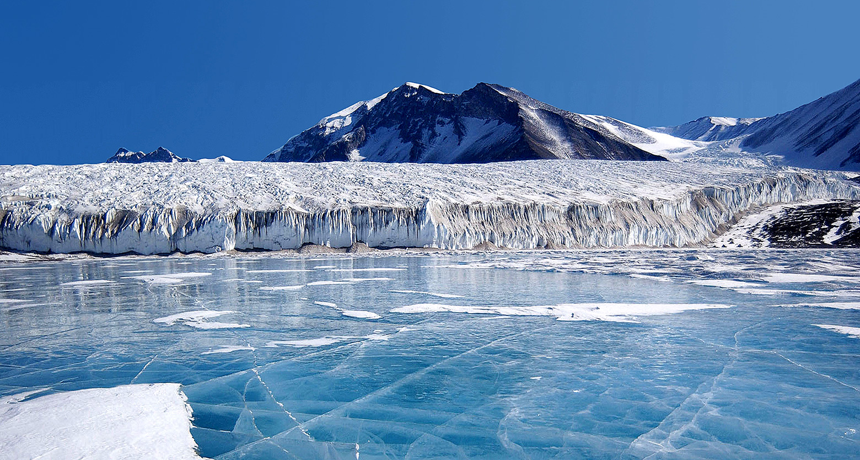Explainer: Antarctica, land of lakes
There are many, although they tend to be buried under rivers of ice

A thick layer of ice covers Lake Fryxell, just one of the many lakes in Antarctica.
Joe Mastroianni, NSF/Wikimedia Commons
By Douglas Fox
Antarctica’s ice isn’t stuck tight, frozen onto the continent like frigid glue. In many places, liquid water sits between the ice and the ground beneath it. This water forms because heat seeping from inside the Earth gradually melts away the bottom of the ice sheet. Layers of water, thinner than a few stacked coins, melt off of the bottom of the ice each year. This water collects in low places, forming lakes. The water flows from one lake to another. Eventually it empties into the ocean.
Scientists have used ice-penetrating radar and other methods to look for water under the ice. In the process, they discovered more than 200 of these subglacial lakes hiding deep below the ice surface. Most are only a few kilometers across. The largest, called Lake Vostok, is 250 kilometers (160 miles) long and 50 kilometers (30 miles) across. It holds about as much water as Lake Michigan, making it the seventh-largest lake on Earth.
Lake Vostok has probably been buried under ice for at least 15 million years. Many other subglacial lakes are a bit younger. The water in all of these lakes comes from snow that fell onto the surface of the Antarctic ice sheet long ago. Water is constantly flowing out of a subglacial lake. It is replaced by new water that flows in. The exchange process is slow. As a result, the water in the lakes has not seen the light of day for up to 500,000 years.
For the past two decades, biologists have wondered what kind of life might survive in these isolated lakes. The first indirect clues began emerging in 1998. Scientists drilling into the ice a few meters above Lake Vostok found layers that came from lake water that had frozen thousands of years earlier. Some single-celled microbes were found in that ancient lake ice. Most of the microbes were dead, but a few still seemed able to grow.
Then, in early 2013, one researcher even reported finding the DNA of a few animals in this lake ice. The researcher claimed that crustaceans, fish, worms and clams might actually still live in Lake Vostok. Many of these claims inspired skepticism from other scientists — especially the claim about animals. Remember: Those claims came from an analysis of the water above, not in, the lake.
But such controversy has made scientists even more anxious to get direct samples of water from the buried lakes. And between December 2012 and January 2013, three teams tried to retrieve samples from three different subglacial lakes in Antarctica.
A British team tried — and failed — to drill into Lake Ellsworth, buried under 3 kilometers (1.9 miles) of ice. Problems steering their drill 300 meters (1,000 feet) down in the ice forced them to abandon efforts for the year.
Two other attempts succeeded. An American team penetrated Lake Whillans, buried under 800 meters (0.5 miles) of ice. And a Russian team drilled down to Lake Vostok, buried under 3.7 kilometers (2.5 miles) of ice.
The subglacial face of Antarctica is as varied as the landscape of any other continent. It includes high mountains, deep valleys, soggy swamps and wide, flat deltas where rivers flow into the ocean. Drilling into these three lakes gave scientists a chance to sample that variety. Each lake is different.
Lake Vostok is a deep “rift lake,” formed by a split in Earth’s crust. It may contain volcanic vents where hot water gushes from deep inside the Earth. Minerals in that water could provide food for exotic life — maybe even the animals that were claimed to live there.
Lake Ellsworth sits in an ancient fjord — a deep mountain valley that a glacier carved long ago as it oozed from the land into the sea. Lake Whillans resembles one of the many shallow, swampy lakes that dot northern Minnesota in the U.S Midwest.
Scientists found living microbes in the water they retrieved from Lake Whillans in late January of 2013. The Russian team pulled some water up from Lake Vostok the same month. (That Vostok water actually was ice. After researchers drilled into the lake a year earlier, water had gushed into the borehole — and promptly froze. A year later the Russian team came back and brought it to the surface for study.)







